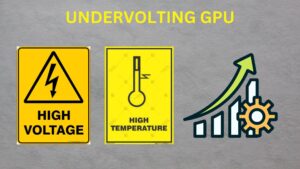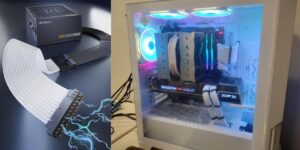Are All PSUs the Same Size?
When building or upgrading a computer, the Power Supply Unit (PSU) is one of the most critical components to consider. It serves as the heart of your system, converting AC power from your wall outlet into the DC power needed to run your computer’s hardware. However, not all PSUs are the same, and one of the most common questions among PC builders is: Are all PSUs the same size? The answer is no. PSUs come in various sizes and form factors, each designed to fit specific types of computer cases and meet different power requirements. From the widely used ATX standard to the compact SFX and TFX form factors, the size of your PSU plays a crucial role in ensuring compatibility and performance. Choosing the right PSU size is essential for a seamless build, as it affects not only the physical fit but also the efficiency and reliability of your system. Let’s explore the different PSU sizes and why they matter.
Understanding PSU Sizes:
Understanding PSU sizes is essential before delving into specifics. PSU size pertains to the physical dimensions, varying among models and manufacturers. This dimension is critical as it dictates fit within your computer case and sufficient power provision for components. Whether a PSU fits and delivers ample power hinges on its size, impacting overall system functionality. Thus, grasping the nuances of PSU sizes ensures optimal compatibility and performance, facilitating informed decisions when selecting and installing a power supply unit for your computer system.
Understanding PSU Form Factors
PSUs come in different sizes and form factors, which are standardized to ensure compatibility with various computer cases and motherboards. The most common PSU form factors are:
EPS (Entry-Level Power Supply)
EPS PSUs are designed for servers and workstations, offering higher power output and efficiency. They are similar in size to ATX PSUs but often include additional connectors and features tailored for enterprise-grade systems.
ATX (Advanced Technology Extended)
The ATX form factor is the most widely used standard for desktop PCs. ATX PSUs typically measure around 150mm (width) x 86mm (height) x 140mm (depth), though the depth can vary slightly depending on the model. These PSUs are designed to fit in mid-tower and full-tower cases, which are the most common types of PC cases.
SFX (Small Form Factor)
SFX PSUs are designed for compact builds, such as mini-ITX or small form factor (SFF) cases. They are significantly smaller than ATX PSUs, measuring around 125mm (width) x 63.5mm (height) x 100mm (depth). Despite their smaller size, many SFX PSUs still deliver sufficient power for high-performance components, making them a popular choice for small gaming PCs or home theater systems.
TFX (Thin Form Factor)
TFX PSUs are even smaller and thinner than SFX units, designed for slim or low-profile cases often used in office PCs or home entertainment systems. They typically measure around 85mm (width) x 65mm (height) x 175mm (depth). While they are less common in gaming or high-performance builds, they are ideal for space-constrained environments.
Flex ATX
Flex ATX PSUs are primarily used in ultra-compact systems, such as mini PCs or servers. They are smaller than SFX and TFX PSUs, with dimensions around 81.5mm (width) x 40.5mm (height) x 150mm (depth). These PSUs are less common in consumer builds but are essential for specialized applications.
Why PSU Size Matters
The size of your PSU is crucial for two main reasons: compatibility and performance.
- Compatibility
Not all PSUs will fit in every computer case. For example, an ATX PSU won’t fit in a case designed for SFX or TFX PSUs. Before purchasing a PSU, it’s essential to check your case’s specifications to ensure the PSU will fit properly. Additionally, some cases come with adapters or brackets to accommodate smaller PSUs, but this isn’t always the case. - Performance
While smaller PSUs like SFX and TFX units can deliver sufficient power for many builds, they may have limitations in terms of wattage and cooling. High-performance systems with powerful GPUs and CPUs often require larger ATX PSUs with higher wattage and better cooling solutions. Choosing the right size PSU ensures your system has enough power and stays cool under load.
Compatibility Factors:
Now, let’s address the primary question: Are all PSUs the same size? The answer is no; PSUs come in various sizes, and their compatibility with your system depends on several factors:
1. Case Compatibility: The first and most crucial consideration is whether your computer case can accommodate the size of the PSU you want to use. Most cases are designed to fit standard ATX PSUs, but smaller cases may require SFX or SFX-L PSUs.
2. Mounting Orientation: Some PSUs are designed to be mounted in different orientations, such as top-mounted or bottom-mounted. Ensure your case supports the orientation of your chosen PSU.
3. Wattage Requirements: The size of your PSU can also affect its wattage output. Smaller PSUs may provide less power than their larger counterparts. Make sure the PSU you choose can meet the power demands of your components.
PSU Form Factors and Cases:
PSU form factors play a crucial role in case compatibility. ATX PSUs fit standard cases, while smaller form factors like SFX, TFX, and Micro ATX cater to compact builds. Choosing the right PSU size ensures it fits properly within the case, avoiding compatibility issues. Different case sizes and layouts may require specific PSU form factors, so understanding these relationships is essential for building a PC that balances performance, space efficiency, and compatibility.
PSU Size and Wattage:
PSU size correlates with wattage capacity, impacting compatibility and performance. Higher-wattage PSUs are often larger to accommodate additional components and cooling systems. Choosing the right size PSU ensures it fits within the case and delivers adequate power for system components. Overestimating wattage can lead to inefficiency, while underestimating may cause instability or damage. Understanding the relationship between PSU size and wattage helps optimize system performance while ensuring reliable power delivery for a wide range of computing tasks.
Choosing the Right PSU Size:
To choose the right PSU size for your build, follow these steps:
1. Check Your Case: Determine your case’s maximum PSU size. Refer to your case’s manual or specifications.
2. Consider Future Upgrades: If you plan to upgrade your components in the future, choose a PSU with some headroom in terms of wattage to accommodate potential additions.
3. Evaluate Power Requirements: Calculate the total power requirements of your components, including the CPU, GPU, drives, and other peripherals. Choose a PSU with sufficient wattage to cover your needs.
4. Check Compatibility: Ensure that the PSU form factor and connectors are compatible with your motherboard and other components.
PSU Size Myths Debunked:
There are a couple of myths surrounding PSU size that need to be debunked:
1. Bigger PSU is Always Better: While a larger PSU can provide more power, it’s not always necessary. Using a vastly oversized PSU can be inefficient and may lead to higher energy bills.
2. Smaller PSUs are Inadequate: Smaller PSUs, such as SFX or SFX-L, are perfectly capable of powering even high-end gaming systems. Don’t underestimate their capabilities based solely on size.
Conclusion
In conclusion, not all PSU sizes are the same. The size of your power supply unit is an important consideration when building or upgrading your computer. It determines whether it will fit in your case, whether it can provide enough power to your components, and whether it’s compatible with your motherboard. When choosing a PSU, carefully assess your case’s compatibility, power requirements, and any future upgrade plans. By selecting the right PSU size, you can ensure a stable and efficient power supply for your computer.
FAQs
1. Can I use an ATX PSU in a Mini-ITX case?
In most cases, an ATX PSU will not fit in a Mini-ITX case due to size constraints. You’ll need to use an SFX or SFX-L PSU designed for compact cases.
2. Are SFX-L PSUs more powerful than SFX PSUs?
SFX-L PSUs are not inherently more powerful than SFX PSUs. Both can offer various wattage options. The key difference is the physical size, with SFX-L PSUs being slightly longer.
3. Should I always choose the highest wattage PSU available?
No, you should choose a PSU with wattage that matches your system’s power requirements. Using a significantly higher wattage PSU than necessary can be inefficient and more expensive.
4. Are there any advantages to using a smaller PSU in a larger case?
Using a smaller PSU in a larger case can create more space for airflow and cable management. However, make sure the smaller PSU provides sufficient power for your components.
5. Can I use a non-standard PSU form factor in a standard case?
It’s generally not recommended to use non-standard PSU form factors in standard cases, as they may not fit or align correctly with the case’s PSU mounting points. Always check compatibility before purchasing a PSU.
Last Updated on 1 February 2025 by Ansa Imran

Ansa Imran, a writer, excels in creating insightful content about technology and gaming. Her articles, known for their clarity and depth, help demystify complex tech topics for a broad audience. Ansa’s work showcases her passion for the latest tech trends and her ability to engage readers with informative, well-researched pieces.







